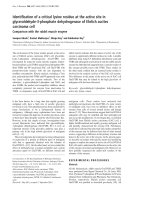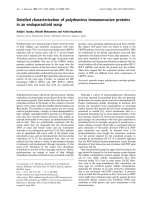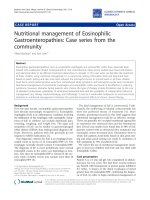Báo cáo y học: "Nutritional management of Eosinophilic Gastroenteropathies: Case series from the community" doc
Bạn đang xem bản rút gọn của tài liệu. Xem và tải ngay bản đầy đủ của tài liệu tại đây (214.45 KB, 4 trang )
CASE REP O R T Open Access
Nutritional management of Eosinophilic
Gastroenteropathies: Case series from the
community
Alfred Basilious
1
and Joel Liem
2*
Abstract
Eosinophilic gastroenteropathies, such as eosinophilic esophagitis and eosinophilic colitis, have classically been
treated with swallowed inhaled corticosteroids or oral corticosteroids. More recent studies have found elimination
and elemental diets to be effective treatment alternatives to steroids. In this case series we describe the treatment
of three children using nutritional management in a community setting. Elimination diets and elemental diets
based on patch testing and skin prick tests reduced the eosinophil counts to normal levels in all three children.
Food items which tested positive were then reintroduced while symptoms and eosinophil counts were monitored.
Nutritional management of eosinophilic esophagitis and eosinophilic colitis was found to be effective in reducing
symptoms. However, obstacles facing patients who choose this type of therapy include limitations due to the cost
of repeated endoscopies, palatability of elimination/elemental diets and the availability of subspecialists trained in
management (e.g. Allergy, Gastroenterology, and Pathology). It may be a worthwhile endeavour to overcome these
obstacles as nutritional management minimizes the potential long-term effects of chronic steroid therapy.
Background
Over the past decade, eosinophilic gastroenteropathies
have become increasingly recognized [1]. Eosinophilic
esophagitis (EoE) is an inflammatory condition involving
the infiltration of the esophagus with eosinophils. Symp-
toms of EoE in children can include abdominal pain,
vomiting, coughing, and weight loss. The signs and
symptoms of EoE can be similar to gastroesophageal
reflux disease (GERD), thus making initial diagnosis dif-
ficult. Moreover, patients with EoE generally do not
respond to GERD medications [2].
One diagnostic criterion for EoE is an esophageal eosi-
nophil count in excess of 15 eosinophils/HPF [2]. The
esophagus normally should contain 0 eosinophils/HPF.
The diagnosis of EC is more problematic since normal
eosinophil counts in the colon vary depending on loca-
tion. Less than 10 eosinophils/HPF is normal in the rec-
tum, while a healthy cecum may contain more than 30
eosinophils/HPF [3].
The ideal management of EoE is controversial. Tradi-
tionally, the swallowing of inhaled corticosteroids has
been the preferred means of treatment [4]. More
recently, promising research in this field suggests that
nutritional management could be an effective strategy.
There are generally two accepted nutritional approaches
to treatment: the elemental diet and the elimination
diet. Several case studies have found that in 98% of EoE
patients treated with an elemental diet, symptoms and
eosinophil counts decreased [4,5]. Elimination diets in
which EoE patients avoid foods based on skin prick test-
ing and atopy patch testing can result in resolution of
EoE symptoms in 75% of patients [6-8].
We report the use of nutritional management strate-
gies to treat two children with EoE and one child with
Eosinophilic Colitis.
Case presentation
Patient A is a 5 year old girl who complained of abdom-
inal pain for two years. She had been treated without
any benefit with lansoprazole (a proton pump inhibitor)
for reflux. A biopsy of the distal esophagus revealed
greater than 20 eosinophils/HPF, confirming the diagno-
sis of EoE. In order to begin nutritional management of
* Correspondence:
2
Allergy and Clinical Immunology/Pediatrics, Schulich School of Medicine
and Dentistry - Windsor Allergy Asthma Education Centre, 1407 Ottawa
Street, Windsor, N8X 2G1, Canada
Full list of author information is available at the end of the article
Basilious and Liem Allergy, Asthma & Clinical Immunology 2011, 7:10
/>ALLERGY, ASTHMA & CLINICAL
IMMUNOLOGY
© 2011 Ba silious and Liem; licensee BioMed Central Ltd. This is a n Open Access article distributed und er the terms of the Cr eative
Commons Attribution License ( .0), w hich permits unre stricted use, distribution, and
reproduction in any medium, provided the original work is properly cited.
her EoE, skin prick tests, patch tests and food specific
IgE tests were done to look for potential allergens
(Table 1). Patient A was started on a 6-week elimination
diet of t he foods that were positive on these tests. The
elimination diet partially relieved her symptoms but
repeat biopsy of the distal esophagus performed after
the elimination diet continued to show an elevated eosi-
nophil count (60 eosinophils/HPF).
As she was still symptomatic and the eosinophil count
remained high, the patient agreed to an elemental diet.
An NG tube (200-400 ml; 4 day feedings and 1 nightly)
was placed and she was fed 200-400 ml Neocate four
times a day and once nightly. Within several weeks, her
abdominal pains subsided. However, the patient experi-
enced difficulties with night-time feedings as she had a
tendency to vomit following these feedings. After seven
weeks, a repeat biopsy showed that the elemental diet
had successfully eliminated the eosinophils in the distal
esophagus.
A reintroduction diet (1 food every 5 days) was begun
in order to identify which foods would cause symptoms
and increase eosinophil counts. Carrots, apples, p ears
and grapes were first introd uced and symptoms did not
return. The introduction of potatoes and string beans
caused symptoms to return, at which time she stopped
eating these foods. Sweet potatoes, peaches, oranges,
bananas, strawberries, tuna, pork and rice were then
introduced without the reoccurrence of symptoms. A
repeat biopsy revealed 1 eosinophil/HPF in the distal
esophagus. Corn and eggs were introduced and stopped
because they caused symptoms to return. Three weeks
after the reintroduction of cow’s milk, wheat and soy, a
biopsy of the distal esophagus showed 18 eosinophils/
HPF. Despite the high eosinophil count, the patient did
not complain of any symptoms. The patient discontin-
ued the consumption of cow’s milk, wheat and soy and
a repeat biopsy performed a month later revealed no
eosinophils in the distal esophagus. Management is still
ongoing with this patient.
Patient B is a 9 ye ar old male who presented with
stomach pains, vomiting and greater than 20 eosino-
phils/HPF in the esophagus. Although he was treated
with a high dose of lansoprazole (30 mg bid) for eight
weeks, a repeat biopsy showed a persistence of the
eosinophils. In short, the lansoprazole failed to relieve
his symptoms. This finding confirmed a diagnosis of
eosinophilic esophagitis. After a two week tr ial with
prednisone, patient B became completely asympto-
matic, thereby providing him with a baseline of what
“normal” should feel like.
Following atopy patch testing the patient started an
elimination diet in which he did not consume foods that
showed positive in the patch testing (Table 1). After
four weeks on the elimination diet, the patient was com-
pletely asymptomatic. A repeat biopsy revealed that the
elimination diet successfully reduced the eosinophil
count to 0-1/HPF.
Patient B then began a reintroduction diet by consum-
ing turkey for a month to further determine which foods
were causing his EoE. In response to turkey, his abdom-
inal pain returned. After stopping his consumption of
turkey, his symptoms subsided within three weeks. The
patient then tried barley, without the return of any
symptoms. Pork and corn, however, caused his abdom-
inal pain to return. After he stopped consuming these
foods his symptoms completely resolved.
Table 1 Summary of Patients’ Allergic Responses to Foods
Patient Positive foods Foods causing increased
eosinophil counts
Foods causing symptoms
after reintroduction
Patient
A
Epicutaneous testing Cow’s milk; wheat; soy Potatoes; string beans; corn;
eggs
• Peanut butter
Serum specific IgE
• Almond; egg; peanuts; wheat
Patch test
• Cow’s milk; wheat; barley; peas; vegetables & turkey; custard; vegetables
& chicken; broccoli, potatoes and cheese casserole
Patient
B
Patch Test NA Turkey; pork; corn
• Turkey; pork; corn; peas; rye; squash; barley
Patient
C
Serum specific IgE NA NA
• Beef; egg; milk; peanut; wheat; banana
Patch test
• Pork; lamb; rye; barley; cucumber; cow’s milk; corn; chicken; beef;
turkey; wheat
Basilious and Liem Allergy, Asthma & Clinical Immunology 2011, 7:10
/>Page 2 of 4
Patient C is a 9 year old male who presented with
chronic GI symptoms, predominantly with diarrhea,
abdominal cramps, and flatulence. He also had beha-
vioural\disruptive problems and ADHD. A biopsy
showed 60 eosinophils/HPF in the descending colon and
the patient was diagnose d with eosinophilic colitis (EC).
A trial of pediapred resolved his abdominal pain com-
pletely. Upon cessation of the pediapred, his abdominal
pain returned.
In order to begin nutritional management of his EC,
patch testing was perfo rmed (see Table 1). He was
started on an elimination diet which relieved his symp-
toms (including disruptive behaviour) within seven
weeks. A repeat biopsy revealed that the elimination
diet had successfully reduced his eosinophil count to
normal levels. Unfortunately, the patient had difficulty
maintaining his elimination diet and he began to con-
sume foods that were positive in the patch test and food
specific IgE. Thus, his abdominal pain returned, while
his behavioural discrepancies and ADHD became more
problematic. The elimination diet was attempted for a
second time and his symptoms subsided again. However,
he refused to maintain this diet for more than two
weeks and he was lost to follow up.
Discussion
In all three cases presented, nutritional management was
successful in eliminating eosinophilic inflammation and
its associated symptoms. Elemental and elimination
diets, used here in a community setting, were effective
treatments for eosinophilic gastroenteropathies. Unfor-
tunately, as they are extremely difficult to maintain, ele-
mental diets do not offer a long-term solution for
eosinophilic gastroenteropathies [9]. Children, such as
patient A, often find NG tube feedings difficult because
they want to consume solid foods. They also express the
desire to consume the foods their friends eat and this
can lead to severe social and psychological problems.
When patient A was switched to an elimination diet,
she was able to maintain this diet, as did patient B.
Nevertheless, even elimination diets can be difficult for
some children, as in the case of patient C who contin-
ued to consume foods that were not permitted in his
elimination diet.
Wefounditbeneficialtoprescribe our patients ster-
oids (pediapred, prednisone) prior to their diets. The
steroid completely eliminated their symptoms to allow
for a “normal” baseline. They were encouraged to com-
pare this normal baseline with their symptoms during
the associated diet. Patients found that the diets pro-
vided them with symptom relief similar to the steroids.
Thus, nutritional management was an equivalent alter-
native to steroids for these children. It should be noted
that one of the obstacles to the use of oral inhaled
corticostero ids is that theymustbeusedindefinitely
[10]. Diets, however, may offer a better alternative to
steroids, as prospective studies have not been done to
determine the long term effects of oral inhaled corticos-
teroid treatment in EoE. We know that long-term use of
prednisone can cause poor growth, adrenal suppression
and bone abnormalities [11].
Unfortunately, promoting nutritional management in
the community setting is not an easy task. We found it
difficult to schedule repea t biopsies after reintroduction
of new foods due to limited health care resources. In
Canada, the cost of repeat endoscopies limits how fre-
quently biopsies can b e taken. Indeed, biopsies are
important in assessing the effects of different foods
since patients can often be asymptomatic but still
develop eosinophilia, as was the case with both patients
A and B, who had high eosinophil counts despite being
asymptomatic. Eosinophils should therefore be reduced
because of their potential long-term effects (esophageal
remodelling, fibrosis, stricture formation) [12]. Without
repeat biopsies, it is difficult to pinpoint the foods that
are causing the eosinophils to return.
Another barrier to successful nutritional management
of EoE is the prohibitive cost o f elemental and elimina-
tion diets, at least for some families. Furthermore, suc-
cessful nutritional managemen t requires the cooperation
of pathologists, GI specialists, allergists, and dieticians,
who may not be available in the same community.
Conclusions
In the cases we have described, nutriti onal management
was seen as an effective and safe alternative to ingestion
of steroids. Its availability as a viable treatment option
will depend on palatability, community resources, and
proper long-term follow up.
Consent
Consent has been obtained from the individuals for the
case series.
List of abbreviations used
ADHD: Attention Deficit Hyperactivity Disorder; EC: Eosinophilic Colitis; EoE:
Eosinophilic esophagitis; GERD: gastroesophageal reflux disease; HPF: High
Power Field; IgE: Immunoglobulin E; NG tube: Nasogastric Tube
Acknowledgements
We would like to thank Dr. Amjad Zaher MD (pediatric gastroenterology)
and the Pathology department at Windsor Regional Hospital for their help in
managing the 3 patients.
We would also like to thank Dave Owen from the University of Windsor
Publishworks for his review of the manuscript.
Author details
1
Department of Biology, University of Windsor, 401 Sunset Avenue, Windsor,
N9B 3P4, Canada.
2
Allergy and Clinical Immunology/Pediatrics, Schulich
School of Medicine and Dentistry - Windsor Allergy Asthma Education
Centre, 1407 Ottawa Street, Windsor, N8X 2G1, Canada.
Basilious and Liem Allergy, Asthma & Clinical Immunology 2011, 7:10
/>Page 3 of 4
Authors’ contributions
JL developed, carried out, evaluated treatment plans and edited the
manuscript. AB wrote the manuscript. Both authors have reviewed and
approved the final manuscript.
Competing interests
The authors declare that they have no competing interests.
Received: 7 February 2011 Accepted: 30 May 2011
Published: 30 May 2011
References
1. Noel RJ, Putnam PE, Rothenberg ME: Eosinophilic Esophagitis. N Engl J
Med 2004, 351:940-1.
2. Furuta GT, Liacouras CA, Collins MH: Rothenberg ME and the FIGERS
subcommittees. Eosinophilic esophagitis in children and adults: a
systematic review and consensus recommendations for diagnosis and
treatment. Gastroenterology 2007, 133(4):1342-63.
3. Okpara N, Aswad B, Baffy G: Eosinophilic colitis. World J Gastroenterol
15:2975-79.
4. Liacouras CA, Spergel JM, Ruchelli E, Verma R, Mascarenhas M, Semeao E,
Flick J, Kelly J, Brown-Whitehorn T, Mamula P, Markowitz JE: Eosinophilic
esophagitis: a 10-year experience in 381 children. Clin Gastroenterol
Hepatol 2005, 3:1198-206.
5. Markowitz JE, Spergel JM, Ruchelli E, Liacouras CA: Elemental diet is an
effective treatment for eosinophilic esophagitis in children and
adolescents. Am J Gastroenterol 2003, 98:777-82.
6. Spergel JM, Andrews T, Brown-Whitehorn TF, Beausoleil JL, Liacouras CA:
Treatment of eosinophilic esophagitis with specific food elimination diet
directed by a combination of skin prick and patch tests. Ann Allergy
Asthma Immunol 2005, 95:336-43.
7. Spergel JM, Beausoleil JL, Mascarenhas M, Liacouras CA: The use of skin
prick tests and patch tests to identify causative foods in eosinophilic
esophagitis. J Allergy Clin Immunol 2002, 109:363-8.
8. Spergel JM, Brown-Whitehorn T, Beausoleil JL, Shuker M, Liacouras CA:
Predictive values for skin prick test and atopy patch test for eosinophilic
esophagitis. J Allergy Clin Immunol 2007, 119:509-11.
9. Spergel JM: Eosinophilic esophagitis in adults and children: evidence for
a food allergy component in many patients. Curr Opin Allergy Cl 2007,
7:274-278.
10. Schaefer ET, Fitzgerald JF, Molleston JP, Croffie JM, Pfefferkorn MD,
Corkins MR, Lim JD, Steiner SJ, Gupta SK: Comparison of oral prednisone
and topical fluticasone in the treatment of eosinophilic esophagitis: a
randomized trial in children. Clin Gastroenterol Hepatol 2008, 6:165-173.
11. Liacouras CA: Pharmacological treatment of eosionphilic esophagitis.
Gastrointest Endoscopy Clin N Am 2008, 18:169-78.
12. Putnam PE: Eosinophilic esophagitis in children: clinical manifestations.
Gastrointest Endoscopy Clin N Am 2008, 18:11-23.
doi:10.1186/1710-1492-7-10
Cite this article as: Basilious and Liem: Nutritional management of
Eosinophilic Gastroenteropathies: Ca se series from the community.
Allergy, Asthma & Clinical Immunology 2011 7:10.
Submit your next manuscript to BioMed Central
and take full advantage of:
• Convenient online submission
• Thorough peer review
• No space constraints or color figure charges
• Immediate publication on acceptance
• Inclusion in PubMed, CAS, Scopus and Google Scholar
• Research which is freely available for redistribution
Submit your manuscript at
www.biomedcentral.com/submit
Basilious and Liem Allergy, Asthma & Clinical Immunology 2011, 7:10
/>Page 4 of 4









